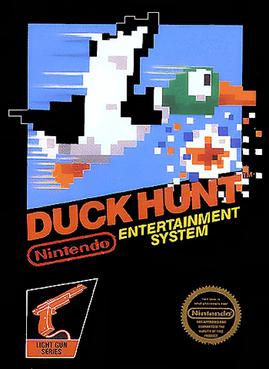
Duck Hunt is a 1984 light gun shooter video game developed and published by Nintendo for the Nintendo Entertainment System (NES). The game was first released in April 1984 in Japan for the Family Computer (Famicom) console and in North America as an arcade game for the Nintendo VS. System. It became a launch game for the NES in North America in October 1985, and was re-released in Europe two years later.
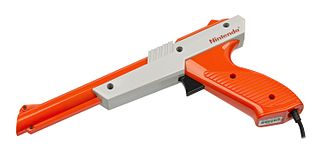
A light gun is a pointing device for computers and a control device for arcade and video games, typically shaped to resemble a pistol.

The Zapper is an electronic light gun accessory launched within the Nintendo Entertainment System (NES) in North America on October 18, 1985. It is a cosmetic redesign by Nintendo of America's head designer Lance Barr, based on Gunpei Yokoi's Video Shooting Series light gun (光線銃シリーズガン), which had been released in Japan for the Famicom on February 18, 1984. The Zapper requires compatible NES games, such as Duck Hunt, Wild Gunman, and Hogan's Alley. Its internal optical sensor allows the player to aim at a television set and accurately shoot at in-game targets.
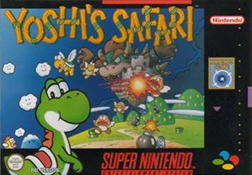
Yoshi's Safari is a 1993 light gun shooter developed and published by Nintendo for its Super Nintendo Entertainment System (SNES). It is the only Mario franchise game to feature first-person shooter gameplay and requires the SNES's Super Scope light gun. As Mario and his pet dinosaur Yoshi, the player embarks on a quest to save the kingdom of Jewelry Land from Bowser and his Koopalings, who have kidnapped its rulers and stolen 12 gems. The game features 12 levels in which the player shoots enemies like Goombas and Koopas, and collects power-ups and coins. At the end of each level, the player engages in a boss fight with an enemy, a Koopaling, or Bowser. Nintendo commissioned its R&D1 department to develop Yoshi's Safari in response to the waning popularity of the Super Scope. Yoshi's Safari was the first Super Scope title to use the SNES's Mode 7 graphics mode, and the future of the peripheral depended on the game's performance.
In video game parlance, a multicart is a cartridge that contains more than one game. Typically, the separate games are available individually for purchase or were previously available individually. For this reason, collections, anthologies, and compilations are considered multicarts. The desirability of the multicart to consumers is that it provides better value, greater convenience, and more portability than the separate games would provide. The advantage to developers is that it allows two or more smaller games to be sold together for the price of one larger game, and provides an opportunity to repackage and sell older games one more time, often with little or no changes.

Hogan's Alley is a light gun shooter video game developed and published by Nintendo. It was released for the Family Computer in 1984 and then the arcade Nintendo VS. System and Nintendo Entertainment System in 1985. It was one of the first hit video games to use a light gun as an input device, along with Nintendo's Duck Hunt (1984). The game presents players with "cardboard cut-outs" of gangsters and innocent civilians. The player must shoot the gangs and spare the innocent people. It was a major arcade hit in the United States and Europe.

Operation Wolf is a light gun shooter arcade game developed by Taito and released in 1987. It was ported to many home systems.

Clay pigeon shooting, also known as clay target shooting, is a shooting sport involving shooting at special flying targets known as "clay pigeons" or "clay targets" with a shotgun. Despite their name, the targets are usually inverted saucers made of pulverized limestone mixed with pitch and a brightly colored pigment.

The ColecoTelstar Marksman, commonly abbreviated as Telstar Marksman, is a first-generation home video game console that featured a light gun. It was released by Coleco in 1978. Because it had a manufacturer-set number of games, it is considered a dedicated console. It was part of the Coleco Telstar series Pong-based home video game consoles; it is essentially a Coleco Telstar Colortron bundled with a "3 in 1" light gun and two shooting games. The Marksman light gun is a pistol that features an attachable stock and barrel. It is similar in this regard to the later-released Stack Light Rifle and the Sega Menacer. The elongated barrel included a simple aiming sight. In addition to the light gun, the system featured two paddle controllers built directly into the console. Its reported features included "on-screen digital scoring" and three different difficulty settings. It required two nine-volt batteries or Coleco's Perma Power AC adaptor to power the system.

Laser Invasion, released as Gun Sight (ガンサイト) in Japan, is a multi-genre first-person action game released by Konami for the Nintendo Entertainment System in 1991. The player takes control of a military operative who pilots an attack helicopter in order to infiltrate various enemy bases and fulfill his mission. The game supports the standard NES controller, as well as the NES Zapper light gun and the LaserScope, a voice-activated headset controller Konami released for the NES that was compatible with all light gun games released for the system. The American version of the game featured a rebate for the LaserScope in the instruction booklet.

Barker Bill's Trick Shooting is a light gun shooter video game developed and published by Nintendo for the Nintendo Entertainment System in 1990.

Big Buck Hunter is a game hunting video game developed by Play Mechanix. Primarily developed for arcades, the goal of the game is to shoot moving bucks or male animals without shooting a doe or female animal.
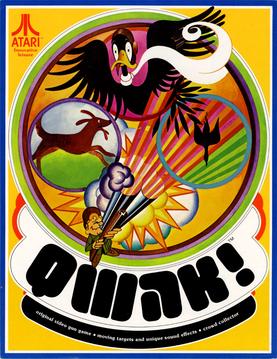
Qwak! is a single-player duck hunting light gun shooter arcade video game developed by Atari subsidiary Cyan Engineering and released in November 1974. In the game, ducks fly one at a time across the screen, and the player shoots at them using a light gun attached to the game cabinet. The player gets three shots per duck; ducks change direction away from missed shots and fall to the bottom of the screen when hit. A screen overlay adds images of reeds and a tree branch, and an image of a duck is added to a row at the top of the screen whenever a duck is hit. Games continue until a time limit, set by the machine operator, is reached.
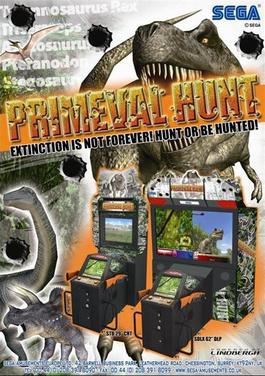
Primeval Hunt is a shooting arcade game which is developed and published by Sega and runs on their Sega Lindbergh hardware. It comes in both standard and deluxe models, with the deluxe version featuring a 62" HD Screen.
Light-gun shooter, also called light-gun game or simply gun game, is a shooter video game genre in which the primary design element is to simulate a shooting gallery by having the player aiming and discharging a gun-shaped controller at a screen. Light-gun shooters revolve around the protagonist shooting virtual targets, either antagonists or inanimate objects, and generally feature action or horror themes and some may employ a humorous, parodic treatment of these conventions. These games typically feature "on-rails" movement, which gives the player control only over aiming; the protagonist's other movements are determined by the game. Games featuring this device are sometimes termed "rail shooters", though this term is also applied to games of other genres in which "on-rails" movement is a feature. Some, particularly later, games give the player greater control over movement and in still others the protagonist does not move at all. On home computer conversions of light-gun shooters, mouse has been often an optional or non-optional replacement for a light gun.
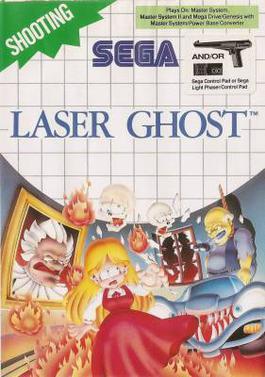
Laser Ghost is a horror-themed light gun shooter arcade video game released by Sega in 1990. The game is patterned after the films Ghostbusters and Poltergeist III, casting the player as a ghost hunter. There are three mounted guns set up on the cabinet, representing the three members of a ghost hunting team. The game puts the players in the role of Bill, Max and Carol, who must rescue a little girl kidnapped by a blue gargoyle, as well as protect the city from the ghost menace. A Master System game with the same title was released in 1991 exclusively for Europe, but was not based on the arcade original.
Police Force is a 1989 Williams pinball machine. The pinball machine was initially supposed to be released as Batman pinball, the police car was to be the Batmobile and the Jail was to be the Bat Cave. The machine features anthropomorphic jungle animals in the roles of police and robbers.
Triple Hunt is a shooter-style arcade game developed by Atari and released in April 1977. Triple Hunt's main feature is its mounted light gun, which is used to shoot at the screen on a separate cabinet. Each Triple Hunt unit houses three changeable games; Witch Hunt, Hit The Bear, and Raccoon Hunt. The game graphics are displayed over the background graphics, and when a monitor mask is placed on the screen, the graphics 'disappear' behind the mask. Since the gun is light operated, the shots would not go through the mask, and did not count. It was first introduced at the Third Annual Distributor Meeting banquet on March 22, 1977.

Cabela's Dangerous Hunts 2013 is a first-person shooter light gun hunting video game developed by Cauldron and published by Activision on October 23, 2012 for PlayStation 3, Xbox 360, Microsoft Windows and Wii. A Wii U port was released later on December 4, 2012. The game's story features Jacob Marshall as he tries to hunt in Africa, while remembering a past hunting trip in Alaska with his father and brother.















